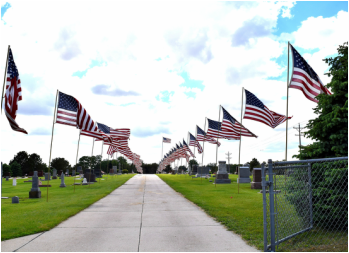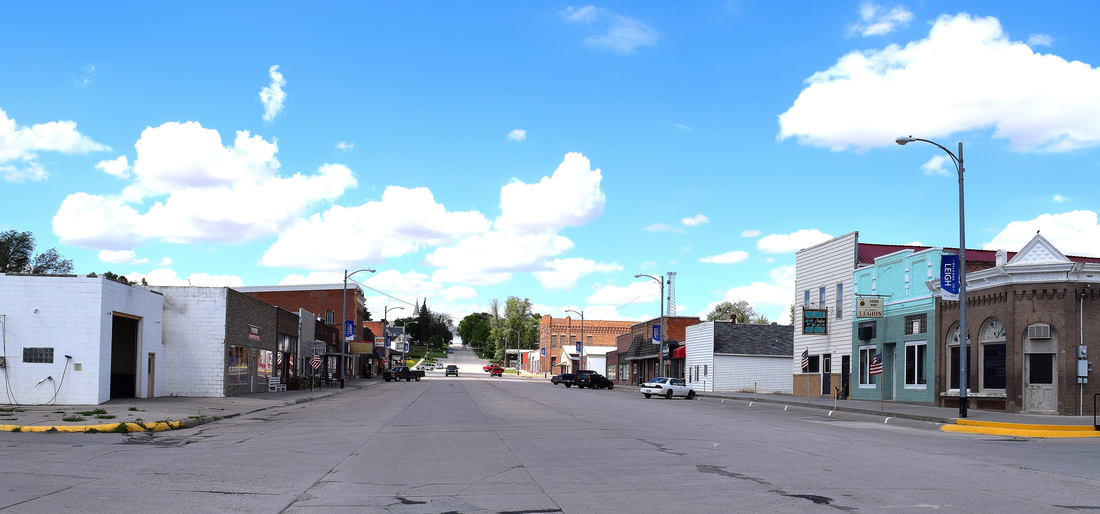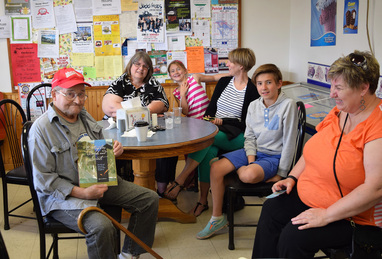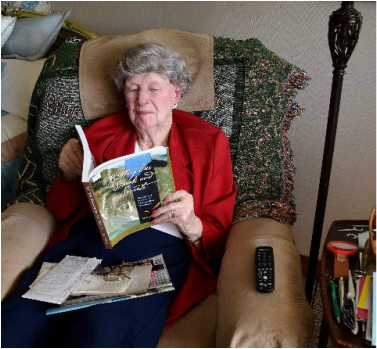When someone in Colorado mentions the State of Nebraska, it is likely that the Cornhuskers come to mind, "Go Big Red” or nowadays, “Omaha, Omaha, Omaha.”
Late this spring, I traveled with my husband, Jim, and our little seven-pound Yorkie, Sophie, up and down the highways from Colorado to Northeast Nebraska. We didn’t venture to any big cities, but were on a mission to bring back an understanding of farming practices used in the communities of early settlers.
We began by stopping in a little town (population 400) of Leigh, Nebraska, 86 miles northeast of Omaha. I came to Leigh to seek out anyone remembering my grandfather, who owned a tavern on Main Street in the 1940s. The town looked abandoned that day—a ghost town. (It reminded me of a poem “Ghost Town” that I had just written.) However, leaving the car and standing smack dab in the middle of Main Street on cracked slabs of concrete, we heard the bustling of laughter coming from a small convenience store/gas station about a half block away at the end of the street.
Late this spring, I traveled with my husband, Jim, and our little seven-pound Yorkie, Sophie, up and down the highways from Colorado to Northeast Nebraska. We didn’t venture to any big cities, but were on a mission to bring back an understanding of farming practices used in the communities of early settlers.
We began by stopping in a little town (population 400) of Leigh, Nebraska, 86 miles northeast of Omaha. I came to Leigh to seek out anyone remembering my grandfather, who owned a tavern on Main Street in the 1940s. The town looked abandoned that day—a ghost town. (It reminded me of a poem “Ghost Town” that I had just written.) However, leaving the car and standing smack dab in the middle of Main Street on cracked slabs of concrete, we heard the bustling of laughter coming from a small convenience store/gas station about a half block away at the end of the street.
Inside the small convenience store, red wooden booths and round wooden tables with black chairs served as a gathering place for locals having their coffee, pop, or other snacks. Old farmers with their kids and grand-kids sat around the table. And best of all, I sat down at a table and captured the memory of one old-timer who remembered razing the tavern (one of the town’s earliest landmarks—formerly the Northwestern Hotel) in 1946. His buddy at the table actually worked for my grandfather. Sure, they remember the old days when pay was $1 an hour for construction or for baling hay. Surrounding farmers would get together and help each other with the labor. Sometimes you would receive hay as payment for your work.
Leaving Leigh, we drove past the fields of dark soil planted in corn. It was too early in the season to see any significant growth, but much of the landscape was verdant with grass pastures, trees and shrubs, and field windbreaks. We looked at the scenic beauty of brown and green hills and valleys on our drive from Leigh. We traveled a few miles west and stopped at a memorial that grasped our attention.
Leaving Leigh, we drove past the fields of dark soil planted in corn. It was too early in the season to see any significant growth, but much of the landscape was verdant with grass pastures, trees and shrubs, and field windbreaks. We looked at the scenic beauty of brown and green hills and valleys on our drive from Leigh. We traveled a few miles west and stopped at a memorial that grasped our attention.

Placed inside a long archway within the open gated-entrance and avenue of Creston Fairview Cemetery were at least three dozen tall, flowing American flags waving high in the air under the cloudy bright blue sky. U.S. Service veterans and other community members had erected this patriotic display to honor their former citizens. It was Memorial Day weekend and the sight of this tribute was breathtaking.
It was only 10 more miles going north to visit the town of Madison, Nebraska (population 1200). My grandparents also owned and managed a tavern in Madison during the 1950s, all the while farming just outside of town. I had come back home to visit with anyone who could recall these grand folks and inform me of farming practices back in the early part of the 20th century.
Madison opened its arms to us. We were in town on a cool and drizzly day, the rain creating barriers to our walking down a side street under re-construction. Divots in the street had become large mud holes and the sidewalks were blocked. We were on our way to meet the director of the Madison Historical Museum, Carol Robertson. Carol is a petite one-woman band with a dynamic personality who became Madison’s Chamber of Commerce for the day. She arranged to unlock the museum and proceed to give us a private showing of the historical displays, all the while discussing the history of Madison. As a special surprise, she arranged to have Gary White, a descendant of one of Madison’s founding fathers, meet with us. He was able to inform us about farming practices and explain the functions of various farming machinery.
Carol and her husband farm outside of Madison and she, also, is well versed in agricultural equipment. Carol had taught home economics at Madison High School and explained some of the domestic farming practices of earlier times.
Most folks had passed who knew my family, but several people directed me to a delightful woman with whom I corresponded earlier. Addie Schmitz is a nonagenarian, active, and congenial. My husband, little Sophie, and I met Addie in her room at a senior community center located north side of Madison. She and her family had been friends of my grandparents. I feel it was a gift to me to have an opportunity to reminisce with her. She could recall my grandparents’ kindness and engaging personalities, and relate a few humorous anecdotes. I learned a lot from this pleasant woman and from her niece, Lois Peterson, who came to visit Addie.
These small towns of Nebraska reflect the soul of communities, hard work, and love of the land. The people are rooted in spirit with the crops, the hardships of their ancestors, and with the memories that they share.
It was only 10 more miles going north to visit the town of Madison, Nebraska (population 1200). My grandparents also owned and managed a tavern in Madison during the 1950s, all the while farming just outside of town. I had come back home to visit with anyone who could recall these grand folks and inform me of farming practices back in the early part of the 20th century.
Madison opened its arms to us. We were in town on a cool and drizzly day, the rain creating barriers to our walking down a side street under re-construction. Divots in the street had become large mud holes and the sidewalks were blocked. We were on our way to meet the director of the Madison Historical Museum, Carol Robertson. Carol is a petite one-woman band with a dynamic personality who became Madison’s Chamber of Commerce for the day. She arranged to unlock the museum and proceed to give us a private showing of the historical displays, all the while discussing the history of Madison. As a special surprise, she arranged to have Gary White, a descendant of one of Madison’s founding fathers, meet with us. He was able to inform us about farming practices and explain the functions of various farming machinery.
Carol and her husband farm outside of Madison and she, also, is well versed in agricultural equipment. Carol had taught home economics at Madison High School and explained some of the domestic farming practices of earlier times.
Most folks had passed who knew my family, but several people directed me to a delightful woman with whom I corresponded earlier. Addie Schmitz is a nonagenarian, active, and congenial. My husband, little Sophie, and I met Addie in her room at a senior community center located north side of Madison. She and her family had been friends of my grandparents. I feel it was a gift to me to have an opportunity to reminisce with her. She could recall my grandparents’ kindness and engaging personalities, and relate a few humorous anecdotes. I learned a lot from this pleasant woman and from her niece, Lois Peterson, who came to visit Addie.
These small towns of Nebraska reflect the soul of communities, hard work, and love of the land. The people are rooted in spirit with the crops, the hardships of their ancestors, and with the memories that they share.
Sharing Butterflies...in Nebraska
Leigh, Nebraska
Addie Schmitz in Madison, Nebraska



 RSS Feed
RSS Feed